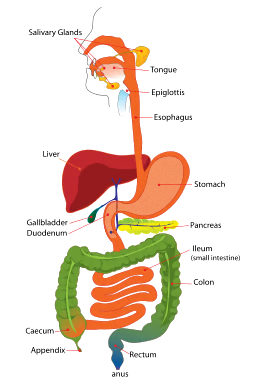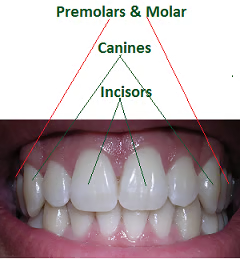My Body and Digestion
Science Four
Introduction: Digestion
Our body works like a machine. As a machine needs energy to run, our body also needs the energy to work.
A machine gets energy from fuel or electricity. In a similar way, our body gets energy from food.
A house is made of bricks. This means brick is the basic unit of a house.
Similarly, our body is made of cells.
Thus Cell is the basic unit of life
Different types of cells together make tissues and different tissues together make organs.
Various organs together make Organ System.
We have different types of Organ Systems for different works.
(a) Digestive system
(b) Nervous system
(c) Circulatory system
(d) Skeleton system and
(e) Excretory system
Digestive system

Fig (1) Digestive System1
We eat different types of food, like rice, bread, vegetables, fruit, milk, egg, fish, etc. All food items have nutrients. These nutrients are carbohydrates, vitamins, proteins, fats, and minerals. These are collectively known as nutrients. These nutrients are found in food. You can tell nutrients as energy because these nutrients give up energy.
Food having nutrients are made of complex materials. Our body gets energy from food using a process called digestion.
Digestion: Breaking down of food into simpler form is called digestion.
Organs involve in digestion:
(a) Mouth
(b) Food pipe
(c) Stomach
(d) Small intestine
(e) Large intestine
Mouth
Digestion starts right from mouth.
A tongue and different types of teeth are present in the mouth. Teeth help to cut and chew the food.
Teeth
There are mainly three types of teeth.
(a) Flat teeth
(b) Pointed teeth
(c) Broad and grooved teeth

Fig (2) Our Teeth2
Flat Teeth
Flat teeth are called incisors. These are situated in the front of the mouth. These flat teeth are used for cutting.
Pointed teeth
Pointed teeth are called canine. The pointed teeth are found on the sides of the mouth. These are used for the tearing of food.
Broad and grooved teeth
Broad and grooved teeth are called pre molar and molar.
Broad and grooved teeth are present at the back inside of the mouth. Broad and grooved teeth are used in grinding the food.
Human beings have two sets of teeth grown in their life. These are our milk teeth and permanent teeth.
Milk teeth
Milk teeth are temporary teeth. Milk teeth appear first. Milk teeth start growing in the first year of life after birth in a healthy child. Milk teeth are twenty in number. Milk teeth start falling from the age of six.
Permanent teeth
After falling of milk teeth, permanent teeth start appearing from the age of six. All permanent teeth come (grown) up to the age of twelve. There are total 32 Permanent Teeth in number.
Tongue
In our mouth we see a long, soft, reddish leaf-like fleshy structure. This is our tongue. We get the taste of food with the help of the tongue.
Tongue helps us in chewing of food.
Tongue helps us to swallow the food.
And tongue helps in speaking.
Salivary glands
There are three pairs of salivary glands present in our mouth. These glands secrete saliva. Saliva mixes with the food and makes the food soft.
Food Pipe
Food pipe has a long pipe-like structure. The food pipe connects our mouth to the stomach. The food we eat goes to the stomach from the mouth through the food pipe.
Esophagus: Food pipe is known as ESOPHAGUS also.
Stomach
Food enters into the stomach from mouth through food pipe.
Stomach is a muscular bag-like structure. Stomach walls secret digestive juices and acid.
Germs if any present in food are killed by acid.
And digestive juices digest the food.
Stomach keeps food from about three to four hours for digestion.
Small intestine
Small intestine has a long thin and coiled structure.
Food from the stomach moves into the small intestine.
The small intestine, liver, and pancreas produce some more digestive juices.
These juices mix with food and digest the food completely.
The walls of the small intestine absorb digested food and pass it to the blood.
Blood carries the nutrients from digested food to all parts of the body.
Large Intestine
Large intestine is a long coiled structure. The large intestine is smaller than the small intestine.
Some undigested foods from the small intestine pass to the large intestine. The large intestine absorbs the water and passes it into the blood.
Rectum
Undigested semi – solid waste is collected in the rectum and is eliminated from the anus from time to time.
Good habits
(a) We should wash our hand before and after eating.
(b) We should eat balance diet.
(c) We should chew food properly before swallowing.
(d) We should drink plenty of water.
(e) We should eat green vegetables every day.
(f) We should not eat unwashed fruits and vegetables because it can carry germs of diseases which can make us ill.
Reference:
1. Fig:1 - By Mariana Ruiz Villarreal(LadyofHats) (Own work) [Public domain], via Wikimedia Commons
2. Fig:2 - "06-10-06smile" by dozenist - Own work. Licensed under CC BY-SA 3.0 via Wikimedia Commons.